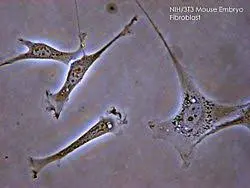From Skin Cells to Stem Cells: The Role of Fibroblasts in Modern Cloning
Fibroblasts are a type of cell found in connective tissue — they play a key role in wound healing and producing the extracellular matrix. In research, fibroblasts are widely used because they are relatively easy to grow in the lab.
Molecular cloning connects to fibroblasts in several ways:
- Gene Expression Studies: Scientists use molecular cloning to insert specific genes into fibroblasts. This helps them study how certain genes affect cell behavior, such as collagen production, cell migration, or tissue repair.
- Protein Production: By cloning a gene of interest into a vector and introducing it into fibroblasts, researchers can make these cells produce large amounts of a desired protein for example, growth factors or therapeutic proteins.
- Reprogramming Cells: Fibroblasts can be reprogrammed into induced pluripotent stem cells (iPSCs) using molecular cloning techniques to deliver transcription factors. This is a major breakthrough for regenerative medicine and personalized therapies.
- Disease Modeling: Cloning mutated genes into fibroblasts allows researchers to create cellular models of diseases like fibrosis or certain genetic disorders. This helps in drug testing and understanding disease mechanisms.
